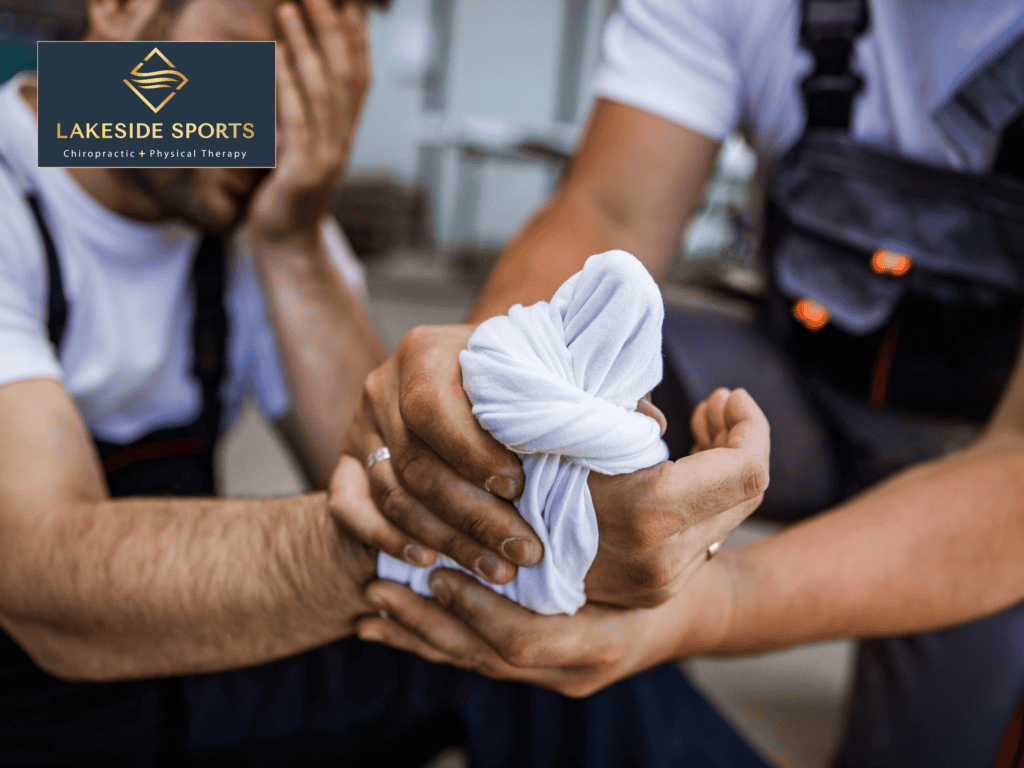To the outside observer, the game of golf may appear relatively lax in terms of physical output. And yet anyone who has invested time into playing the sport knows that despite its seemingly leisurely appearance golf is a game that often requires top-notch physicality, particularly for professionals and enthusiasts.
Furthermore, like any other type of athlete, golfers can fall victim to physical injury. With injuries ranging from mild to severe, it’s important for golfers to be mindful of their bodies and that includes taking care of them and also taking preventative action against injury.
While there is no guaranteed method for outsmarting injury there are certainly ways to mitigate your exposure to them. For golf, specifically multiple methods created by TPI-accredited professionals, were crafted to help golfers not only improve their game but preserve their bodies in the process. In this post we’ll break down the most common injuries that golfers face, how these injuries can affect them long term, and then we’ll transition into defining what TPI is and how it aims to revolutionize golf injury prevention.

The High Stakes Injuries of Golf
Compared to high-impact sports or sports that utilize player-to-player contact, golf may appear relatively benign, all things considered. While this may be true to some degree it’s important to never underestimate the potential physical side effects of any sport. Point blank, no matter how seemingly relaxed they may appear, any sport can cause injury which is why it’s important to be vigilant and understand exactly what you’re up against with the sport in question.
By nature, golf is a sport that requires the player to engage in a lot of repetitive movements. This tends to put a lot of stress on certain parts of the body for prolonged periods of time. Here are some of the most common injuries that accompany golf, and their potential side effects if left untreated.
Back Pain: If you’ve ever watched a golfer swing, you’ve probably noticed that they heavily contort and twist their body. This leads to a lot of unnatural bending of the spine, which can cause muscle strains, disc herniations, and even spinal fractures. Long term back pain can significantly affect the golfers’ mobility, posture, and swing, often leading to chronic pain issues like sciatica or arthritis.
Elbow Pain: Golfers regularly experience inflammation of the tendons, specifically the ones that connect the forearm muscles to the elbow joint. In fact, this pain is so common among golfers that it’s been given the name golfers elbow otherwise known as medial epicondylitis. This condition is known to cause pain and stiffness, over time affecting the golfer’s ability to grip. True to its name, the golfer’s elbow ultimately affects the player’s ability to swing the club effectively.
Shoulder Pain: Many golfers also suffer from chronic shoulder pain, the consequence of repeated shoulder movements. In short order, golfers can sustain injuries to the shoulder joint and the surrounding muscles, ligaments, and tendons. Common shoulder injuries for golfers include rotator cuff tears, impingement syndrome, and bursitis. These injuries are known to cause pain. inflammation and reduce the golfer’s overall range of motion which will ultimately affect the individual’s ability to exert power and swing with accuracy.
Knee Pain: Given the nature of golf, most people can put two and two together, understanding that shoulder and elbow pain are par for the course. However, many don’t realize that knee pain is also a common side effect of golfing. This is because golfers put a lot of stress on their knees during the swinging process. Moreover, if the player has poor technique or alignment, the twisting and pivoting of the knee can cause damage to the cartilage, meniscus, and/or ligaments. The result? The golfer can suffer from serious injuries such as meniscal tears or anterior cruciate ligament (ACL) sprains. Knee pain can furthermore impair golfers’ stability and balance, leaving them susceptible to other lower body injuries.
Why Prevention Matters
Best case scenario? Golf injuries can put you in temporary a state of discomfort. Worst case scenario? Golfing injuries can leave you facing permanent discomfort and pain, put you on the hook for costly surgeries, and have you beholden to intensive and prolonged healing care, which often includes intensive bouts of physical therapy. As with almost anything in life, it is far more advisable to invest in prevention than it is to be strapped with avoidable, serious consequences which for the athletes are undoubtedly physical in nature.

Introducing TPI: The Modern Golfer’s Key to Prevention
Fortunately, there are quite a few preventative measures that golfers can take to help preserve their bodies and ensure that they are taking adequate care of their physical being. One of these methods has proven to be extremely effective and that is TPI.
TPI is an abbreviation for Titleist Performance Institute, which is a leading organization specializing in golf fitness, player health, and swing biomechanics. Golf coaches, trainers, physical therapists, and medical professionals can obtain this credential which allows them to assess and improve the physical capabilities of golfers. TPI is constantly evolving to reflect the newest research and technology, which means that golfers who work with TPI professionals can effectively improve their performance, prevent injury, and recover faster if they sustain an injury.
How TPI Professionals Help Players Prevent Injuries
Now that you’re aware of the existence of TPI accreditation, you may be wondering how exactly a TPI-certified professional helps golfers prevent injuries. TPI-certified professionals will often create personalized plans that cater to the specific player, helping them to implement proper posture, proper alignment, and stable balance into their swing. Specifically, they can teach golfers how to adopt a neutral spine position and properly align their head, shoulders, hips, knees, and feet, to distribute weight evenly on both feet. Proper alignment and posture not only help to prevent injury but also help to improve the golfers’ overall game.
Getting Started with a TPI-Certified Provider
Whether you’re just getting started in your golfing journey or have been playing the beloved sport for decades it’s never too late to start investing in preventative measures. Reputable providers like those at Lakeside Sports Chiropractic, located in the greater Charlotte NC metropolitan area, are here to help athletes not only prevent injury but improve their game. You owe it to yourself. Get aligned with a TPI-accredited professional today and reap the benefits tomorrow.
At Lakeside Sports Chiropractic and Physical Therapy, Dr. Jennifer Lidstrom and her team of experts Cornelius Chiropractors are here to help answer all your questions. Please feel free to contact us today via phone at (704)-896-8446 or visit us at our new location:
11220 Treynorth Drive, Suite A
Cornelius, NC 28031
United States
Disclaimer:
The information provided in this article is for general informational purposes only and should not be considered professional advice. The content of this article is not intended to be a substitute for professional medical or healthcare advice, diagnosis, or treatment. Always seek the advice of your chiropractor, physician, or other qualified healthcare provider with any questions you may have regarding a medical condition or treatment.
The views expressed in this article are solely those of the author and do not necessarily represent the views of Lakeside Sports Chiropractic and Physical Therapy or its staff. Lakeside Sports Chiropractic and Physical Therapy does not endorse or recommend any specific treatment, product, procedure, or opinion mentioned in this blog post.
Reliance on any information provided in this article is solely at your own risk. Lakeside Sports Chiropractic and Physical Therapy and its staff will not be liable for any direct, indirect, special, or consequential damages arising out of the use of, or reliance on, the content provided in this post.
While we make every effort to ensure that the information provided in this article is accurate and up-to-date, we cannot guarantee its completeness or accuracy. The information in this post may be subject to change without notice.
Any links provided in this post are for informational purposes only and do not imply endorsement or sponsorship of the linked website or its content.
By reading this post, you acknowledge and agree to the above disclaimer. If you do not agree with this disclaimer, please refrain from accessing or using the information provided in this post.



